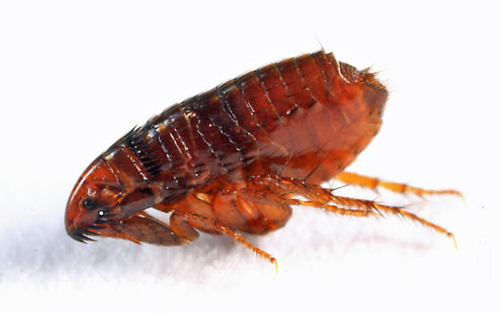Summary
Adult fleas are attracted to light. They’re most attracted to green-yellow light (500-530 nm). They can’t see red light (above 600 nm). When the light is quickly turned off and on, fleas perceive it as a shadow from a potential host. As a result, intermittent light attracts up to 8 times as many fleas as continuous light.
Details
Fleas are primarily attracted to hosts through visual and thermal cues. However, a combination of numerous stimuli produce the best attraction response, as they reinforce the accuracy of host detection.
Flea Eyes are Light Sensors
Adult fleas have two eyes. However, instead of compound eyes, fleas have simple, black eye-spots with a single biconvex lens Img 1. They can see changes in light intensity, but can’t form acute visual images.

Img 1 Adult cat fleas have simple, black “eyespots” that detect changes light.
Phototaxis
Phototaxis is a term describing response to light. Cat fleas are positively phototactic, meaning they’re attracted towards sources of light. In one experiment, adult fleas were placed in a dark area. Within 40 minutes, 93% of them moved to a lighted area.
In natural settings, emerging adults climb atop nearby objects, such as the tips of carpet fibers. There they orient themselves towards light sources while waiting for a host. Adult fleas tend to gather near openings where light passes through, for instance, crawl spaces, window sills, and entrances to animal shelters.
Color of Light
Fleas can detect wavelengths between 300 and 600 nanometers. They can’t see red light (above 600 nm). Cat fleas are most attracted to green-yellow light, specifically wavelengths between 500 and 530 nm Fig 1. It attracts over twice as many fleas as standard light. Altering flea traps with a green-yellow filter significantly improves performance.
Fig 1 Percent response of cat fleas (y-axis) to different wavelengths of light in nanometers (x-axis) compared against 345 nm light.
Light passing through light-green and yellow-green filters also attract more fleas than white light (1.67 and 1.15 times, respectively). Blue and green filters are similar to standard light. Other colors perform worse than white light. Red, magenta, and pink filters attract the fewest fleas. This is because fleas can’t see the red part of the spectrum.
Intermittent Light
Movement attracts cat fleas. As a result, fleas respond strongly to a light source when it’s interrupted briefly (10 minutes on, 5 seconds off). The interruption mimics a shadow cast by a host passing in front of the light. Fleas then jump in the direction of the perceived shadow. Flea traps with intermittent light are 5-8 times more effective than continuous light.
Time of Day
Fleas are most active a few hours before sunset. Their activity remains high throughout the night. Lighted flea traps attract significantly more fleas at night than during the day.





You must log in to post a comment. Log in now.
How close, and/or bright, does the light need to be for fleas to respond?
The light should attracts fleas within a room. Most studies were done in a small room. Victor’s Flea Trap states 30 feet in all directions. I am not sure about brightness.